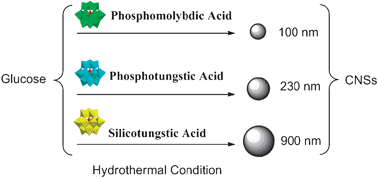Large-scale and monodisperse colloidal carbon nanospheres (CNSs) were synthesized with the assistance of polyoxometalates (POMs) under hydrothermal conditions. The POMs could act not only as a catalyst to promote the glucose dehydration process, but also as a stabilizer to prevent the aggregation of CNSs. The products were characterized by scanning electron microscopy (SEM), transmission electron microscopy (TEM) and Fourier-transform infrared spectroscopy (FT-IR). The diameters of CNSs from 100 nm to 900 nm can be controlled by different acidic and oxidizing properties of POMs. This method was demonstrated to be simple, reliable and reproducible. The conversion yield of CNSs prepared with the addition of phosphomolybdic acid was up to 37%. Based on the experiment, the possible mechanism for CNSs formation was proposed. After modification of CNSs with cysteine, the samples were utilized as electrode materials for sensitive heavy metal ions detection. The detection limits for lead(II) and cadmium(II) were 1 × 10−8 M and 2 × 10−7 M, respectively. The results highlight the potential application of CNSs as electrode materials for biosensors and catalysis.

You have access to this article
 Please wait while we load your content...
Something went wrong. Try again?
Please wait while we load your content...
Something went wrong. Try again?


 Please wait while we load your content...
Please wait while we load your content...